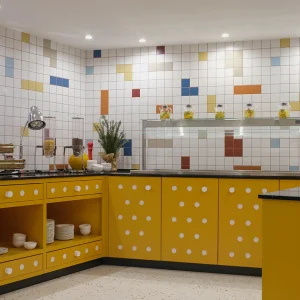
Andreas Ruby, Nathalie Janson
The combined effects of rising house prices and a sluggish economy are putting home ownership beyond the reach of a younger generation. Those determined not to become slaves to rent are forced to look to the suburbs for homes they can afford. But rather than sacrificing the opportunities and amenities available in the city, why not lower barriers to home ownership by cutting out the middleman – the developer?
This is the main idea behind the Baugruppe (building group), a German building process in which future homeowners ‘self-develop’ their own building. The process usually works in one of two ways: either a community operating as a legal partnership buys a plot of land and hires an architect, or an architect initiates and carries out the entire development of the project for a group formed around the building and often a shared lifestyle. Cutting out the developer, the profit margin, and any marketing costs reduces the price of an apartment in Berlin by 25 per cent to 30 per cent. The building group phenomenon has made home ownership attainable for many middle-class households in Germany, where bank mortgages require a down payment of 20 per cent to 30 per cent. Renting is still the norm in Germany, but home ownership will become an increasingly important safety net as state pensions decrease.
While developer-driven apartments are usually designed for a notionally ‘average’ user, the members of a building group are able to define their needs and incorporate these in the design process. The result is a home tailored to specific needs. Our office, for example, which is located in a building group-developed building, is intended as the future living space of a live-in caretaker. This amenity will allow the current residents to age in place. We also share several facilities with our neighbours – an outdoor garden, a meeting space and communal kitchen, a panoramic rooftop and an indoor bike shed – that provide some of the family-friendly qualities of the suburbs.

What’s more, people get to know their neighbours in the process of self-developing their own homes. Factoring in individual schedules and reaching consensus as a group is a time-consuming community-building exercise. The pay-off is a sense of trust and respect which allows enjoyment of dense city living without the usual disadvantages. Neighbours are less likely to sit on their properties as investments or blast music into the early hours and more likely to keep a copy of your key, take turns keeping a watchful eye on the children, and take in your UPS packages.
The sense of community and belonging nurtured by self-developing is not only good for residents, it’s good for the city. The only alternative for a family with a budget of €220,000 (£184,716) would be to leave the city for the suburbs. Thanks to building-group projects they can choose to stay. In that sense, Baugruppe represents a bottom-up strategy for achieving urban densification and avoiding sprawl. For the city, it means not only retaining its tax base, but also encouraging residents to invest in and help to improve their neighbourhoods, which is notable as Berlin becomes home to an increasingly international and itinerant community. Many buildings groups are also driving the incorporation of sustainability into housing, with homeowners making long-term decisions to lower operating costs and limit their impact on the environment.
It’s hard to imagine how a model such as the building group would apply to cities like London, Paris or Barcelona, with low availability of buildable land in the city; the model is also becoming less realisable in Berlin because of growing pressure on land. The building-group movement emerged out of a particular context after the fall of the Berlin Wall; plots in the city exceeded demand and density in central neighbourhoods was much lower than before the Second World War. Today, groups wishing to self-develop are increasingly competing with commercial developers in a frenzy to buy up available land. In this situation, the building group suffers from a structural disadvantage: it takes time to form, collect down payments, and reach a consensus. By the time the group is organised, investors who can provide upfront payments have already snapped up the land.
There are many reasons why cities should encourage initiatives like the building group -the image of the city, the well-being of its residents, and sustainability, to name just a few – and we can look to other German cities for inspiration. Hamburg has supported the movement by setting aside 20 per cent of its land to building-group projects. As we stumble ahead in this slow economy, cities need to help their communities help themselves.





